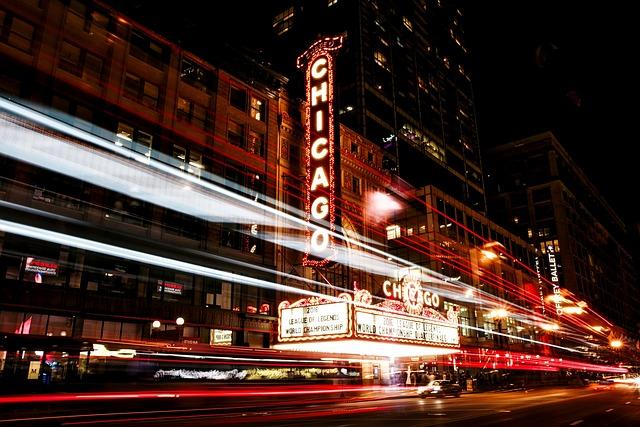Is Chicago the violent crime capital of the United States? This question has long shaped public perception and media narratives about the city, often painting it as a hub of relentless violence. However, a closer examination of crime statistics and trends reveals a more nuanced story. In this article, Al Jazeera delves into the data, compares ChicagoŌĆÖs crime rates with other major cities, and explores the factors driving violence in urban America to provide a clearer understanding of where Chicago stands in the national landscape of violent crime.
Chicago Crime Rates in National Context Examining Data Beyond the Headlines
When breaking down crime rates across the United States, Chicago often finds itself spotlighted as the epicenter of violent crime. However, a deeper dive into national statistics challenges this narrative. While Chicago does experience significantly high rates of gun violence, other cities such as St. Louis, Baltimore, and New Orleans report higher per capita rates of violent crime. The FBI’s Uniform Crime Reporting (UCR) program underscores that Chicago’s sheer population size contributes heavily to its total crime numbers, creating a perception that may not accurately reflect its rank when adjusted for population.
Key metrics highlight the complexity behind the headlines:
- Violent Crime Rate per 100,000 residents (2023): Chicago at 940, St. Louis at 1,900, Baltimore at 1,700
- Homicide Rate: Chicago reports approximately 18 homicides per 100,000, whereas St. Louis exceeds 60
- Trends: While Chicago saw a surge in 2020-2021, recent data shows a slight decline, with some other cities recording increasing levels
| City | Population (Millions) | Violent Crime Rate | Homicides (per 100k) |
|---|---|---|---|
| Chicago, IL | 2.7 | 940 | 18 |
| St. Louis, MO | 0.3 | 1,900 | 60 |
| Baltimore, MD | 0.6 | 1,700 | 55 |
| New Orleans, LA | 0.4 | 1,200 | 30 |
Factors Contributing to Violent Crime Trends in Chicago Socioeconomic and Policy Perspectives
ChicagoŌĆÖs violent crime rates are often tied to deep-rooted socioeconomic challenges that shape the city’s landscape. High poverty rates, unemployment, and a lack of affordable housing create environments where crime can flourish. Neighborhoods struggling with underfunded schools and limited access to social services frequently report higher incidences of violence. These structural inequities, compounded by systemic racial segregation, contribute to a cycle that is difficult to break without comprehensive community investment.
Policy decisions around law enforcement and criminal justice have also played a crucial role in shaping crime trends. For instance, shifts in policing practices, budget allocations, and community relations impact how effectively violence is managed and prevented. While some advocate for increased police presence, others emphasize restorative justice and social programs aimed at prevention rather than punishment. Below is a snapshot of key socioeconomic indicators influencing violent crime in Chicago compared with national averages:
| Indicator | Chicago | US Average |
|---|---|---|
| Poverty Rate | 20.1% | 13.4% |
| Unemployment Rate | 8.2% | 6.0% |
| High School Graduation Rate | 78% | 85% |
| Police Per Capita | 2.4 officers/1,000 residents | 2.0 officers/1,000 residents |
- Economic hardship: Directly correlates with increased crime probability.
- Community trust in law enforcement: Impacts cooperation and crime reporting.
- Urban policy focus: Determines resources for prevention vs. enforcement.
Debunking Common Myths About ChicagoŌĆÖs Crime Statistics Media Representation and Public Perception
Perceptions of Chicago as the violent crime capital often stem from selective media coverage that highlights shootings and homicides without contextualizing them within broader crime trends or population factors. While Chicago experiences challenges connected to gun violence, the data reveals that the city does not top national crime charts when adjusted for population size or compared across metropolitan areas. Crime rates fluctuate significantly across neighborhoods, with many parts of the city reporting levels of safety comparable to other major urban centers. Moreover, Chicago’s homicide count, often misleadingly cited as the highest, must be understood within a larger narrative that excludes other forms of violent and non-violent crimes and ignores longer-term downward trends.
To illustrate, consider the following comparison of violent crime rates per 100,000 people in selected U.S. cities for 2023:
| City | Violent Crime Rate | Homicides |
|---|---|---|
| Chicago, IL | 950 | 520 |
| Detroit, MI | 1,700 | 330 |
| Baltimore, MD | 1,300 | 305 |
| St. Louis, MO | 1,600 | 210 |
| New York City, NY | 540 | 330 |
The data above shows that while Chicago’s homicide numbers receive heavy media attention, other cities frequently experience higher violent crime rates. This disproves the oversimplified narrative often projected nationally. Public perception is further skewed by disproportionate reporting on specific crime types and neighborhoods, overshadowing efforts in community revitalization, policing reforms, and social programs aimed at reducing violence. Understanding Chicago’s crime requires dissecting complex socioeconomic drivers and avoiding sensational headlines that distort reality.
Policy Recommendations for Reducing Violence Community Engagement and Law Enforcement Strategies
To effectively diminish violent crime rates, a multifaceted approach centered on community engagement alongside enhanced law enforcement strategies is paramount. Building trust between residents and police departments plays a pivotal role, fostering open communication channels that encourage community members to report crimes without fear of retaliation. Programs promoting mentorship, youth empowerment, and conflict resolution within neighborhoods can disrupt cycles of violence before they escalate. Equally important is the increased presence of community liaisonsŌĆöofficers dedicated to understanding local concerns and addressing root causes rather than merely responding to incidents.
- Invest in Youth Programs: After-school initiatives, vocational training, and mental health support.
- Enhance Police Transparency: Body cameras, public oversight committees, and timely incident reporting.
- Facilitate Community Policing: Neighborhood patrols, partnership forums, and local advisory boards.
- Address Socioeconomic Factors: Employment opportunities, affordable housing, and education access.
Incorporating data-driven policing also informs tactical deployment, optimizing resource allocation to hotspots without overwhelming communities. Training officers in de-escalation techniques and cultural competency reduces confrontations and fosters mutual respect. Below is a snapshot comparison of key strategies implemented in various metropolitan areas showing measurable impact on violence reduction within a 12-month period:
| Strategy | City | Violent Crime Reduction | Community Approval Rating |
|---|---|---|---|
| Community Policing | Boston | 15% | 82% |
| Youth Outreach & Mentorship | Detroit | 12% | 74% |
| Data-Driven Patrols | New York | 18% | 79% |
| De-escalation Training | San Francisco | 10% | 85% |
Future Outlook
In conclusion, while Chicago often makes headlines for its high-profile violent crimes, a closer examination of the data reveals a more nuanced reality. Compared to other U.S. cities, Chicago’s violent crime rates are significant but not unprecedented, and factors such as population size, economic disparities, and policing policies all play critical roles. Understanding the complexities behind the statistics is essential to moving beyond sensationalism and addressing the root causes of violence. As the debate continues, balanced reporting and informed public discourse remain vital in shaping effective solutions for safer communities nationwide.




